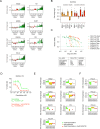MS CETSA deep functional proteomics uncovers DNA repair programs leading to gemcitabine resistance
- PMID: 40335468
- PMCID: PMC12059070
- DOI: 10.1038/s41467-025-59505-8
MS CETSA deep functional proteomics uncovers DNA repair programs leading to gemcitabine resistance
Abstract
Mechanisms for resistance to cytotoxic cancer drugs are dependent on dynamic changes in the biochemistry of cellular pathways, information which is hard to obtain at the systems level. Here we use a deep functional proteomics implementation of the Cellular Thermal Shift Assay to reveal a range of induced biochemical responses to gemcitabine in resistant and sensitive diffuse large B cell lymphoma cell lines. Initial responses in both, gemcitabine resistant and sensitive cells, reflect known targeted effects by gemcitabine on ribonucleotide reductase and DNA damage responses. However, later responses diverge dramatically where sensitive cells show induction of characteristic CETSA signals for early apoptosis, while resistant cells reveal biochemical modulations reflecting transition through a distinct DNA-damage signaling state, including opening of cell cycle checkpoints and induction of translesion DNA synthesis programs, allowing bypass of damaged DNA-adducts. The results also show the induction of a protein ensemble, labeled the Auxiliary DNA Damage Repair, likely supporting DNA replication at damaged sites that can be attenuated in resistant cells by an ATR inhibitor, thus re-establishing gemcitabine sensitivity and demonstrating ATR as a key signaling node of this response.
© 2025. The Author(s).
Conflict of interest statement
Competing interests: P.N. is the inventor of patents related to the CETSA method and is a cofounder and board member of Pelago Biosciences AB. The remaining authors declare no competing interests.
Figures







References
-
- Bardenheuer, W. et al. Resistance to cytarabine and gemcitabine and in vitro selection of transduced cells after retroviral expression of cytidine deaminase in human hematopoietic progenitor cells. Leukemia19, 2281–2288 (2005). - PubMed
-
- Pommier, Y., Sordet, O., Antony, S., Hayward, R. L. & Kohn, K. W. Apoptosis defects and chemotherapy resistance: molecular interaction maps and networks. Oncogene23, 2934–2949 (2004). - PubMed
-
- Kobayashi, S. et al. EGFR Mutation and Resistance of Non–Small-Cell Lung Cancer to Gefitinib. N. Engl. J. Med.352, 786–792 (2005). - PubMed
-
- Engelman, J. A. et al. MET amplification leads to gefitinib resistance in lung cancer by activating ERBB3 signaling. Science316, 1039–1043 (2007). - PubMed
MeSH terms
Substances
Grants and funding
LinkOut - more resources
Full Text Sources
Miscellaneous

